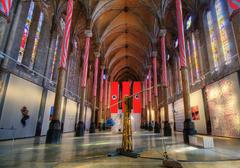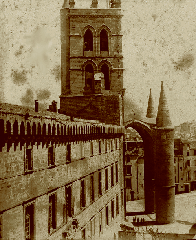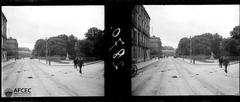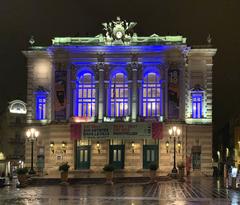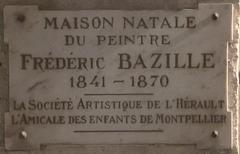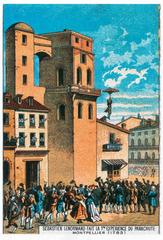Former Penitentiary of Montpellier: Complete Visitor Guide, History, and Practical Insights
Date: 14/06/2025
Introduction: Discovering Montpellier’s Hidden Heritage
Situated in the heart of Montpellier, France, the Former Penitentiary of Montpellier—locally known as the “Ancienne Prison de Montpellier”—serves as a striking symbol of the city’s judicial and architectural legacy. This historic site opens a window into the evolution of penal systems and correctional philosophies from the 19th century through modern times. Constructed during a period of rapid urban transformation, the penitentiary was shaped by panopticon-inspired principles, reflecting contemporary ideals of discipline, surveillance, and reform.
Today, the former penitentiary stands as a testament to Montpellier’s commitment to heritage preservation and public engagement. Its transformation from a place of incarceration to a cultural landmark and educational hub allows visitors to explore its imposing architecture, learn about its role in the justice system, and reflect on the stories of those once confined within its walls (Montpellier History; Montpellier France Tourism; Eastern State Penitentiary).
Table of Contents
- Introduction: Discovering Montpellier’s Hidden Heritage
- Origins and Construction
- Architectural Features and Layout
- The Penitentiary’s Role in Judicial History
- Historical Significance and Transformation
- Decline, Closure, and Adaptive Reuse
- Visitor Information: Hours, Tickets, and Guided Tours
- The Penitentiary in Montpellier’s Urban Context
- Events, Exhibitions, and Educational Initiatives
- FAQs
- Conclusion and Recommendations
- References and Further Reading
Origins and Construction
The origins of the Former Penitentiary date back to the mid-to-late 19th century, coinciding with a wave of urban modernization in Montpellier (Montpellier History). In response to the city’s growth and evolving legal norms, a centralized facility was envisioned to embody the latest advances in penal architecture—primarily surveillance, order, and the potential for reform. The resulting structure featured thick stone walls, secure cell blocks, and a layout inspired by the panopticon model, a testament to the era’s belief in observation as a tool for discipline (History and Evolution of Correctional Systems).
Architectural Features and Layout
Exterior:
The penitentiary’s fortress-like façade, constructed from locally quarried limestone, asserts the authority and permanence of the French state. High perimeter walls, iron-barred windows, and a monumental entrance were designed to deter escape and underscore the seriousness of incarceration.
Interior:
Within, a central corridor or rotunda radiates into multiple cell blocks, enabling efficient surveillance with minimal staff. Cells are small, austere, and sparsely furnished, reflecting the punitive philosophies of the time. Communal areas—such as chapels and workshops—were incorporated to support emerging rehabilitative ideals (facts.net).
Preservation and Reuse:
After its closure, the penitentiary underwent adaptive reuse, with careful restoration preserving its architectural character while introducing spaces for exhibitions and public events (facts.net).
The Penitentiary’s Role in Judicial History
Throughout its operational years, the penitentiary held a central place in Montpellier’s justice system. It housed pretrial detainees, sentenced inmates, and, at times, political prisoners (Montpellier History Facts and Timeline). National penal reforms gradually introduced educational and vocational programs, aligning the facility with evolving standards of detention and rehabilitation.
Historical Significance and Transformation
The penitentiary witnessed key social and political moments, including the detention of political dissidents during the Third Republic and the influence of international penal reform movements (IPPF History). Its story offers insight into the broader journey of French justice—from punitive isolation to a focus on human rights.
By the late 20th century, shifting penal philosophies and infrastructure challenges led to its closure (Montpellier Tourism History). In recent years, the building has been reimagined as a museum, memorial, and cultural venue, ensuring its continued relevance in Montpellier’s civic life.
Visitor Information: Hours, Tickets, and Guided Tours
Opening Hours:
- Tuesday–Sunday: 10:00 AM to 6:00 PM
- Closed on Mondays and public holidays
- Last admission: 5:30 PM
- Hours may vary during special events (Montpellier France Tourism)
Tickets:
- Adults: €8–€12
- Students/Seniors: €5–€8
- Children under 12: Free
- Group tours (up to 30): from €170
- Purchase online or at the site; advance booking strongly recommended
Guided Tours:
- Mandatory for most visits due to preservation and safety concerns
- Available in French and English (seasonally, according to demand)
- Duration: 60–90 minutes
- Thematic tours offered during festivals and special events
- Educational tours for school groups
Accessibility:
- Main exhibition areas are wheelchair accessible, but some historic zones with stairs and narrow passages may be challenging. Contact the site for specific accommodations.
Photography:
- Permitted for personal use in most areas; restrictions may apply in special exhibitions.
The Penitentiary in Montpellier’s Urban Context
Located near the city center, the Former Penitentiary is surrounded by landmarks such as Place de la Comédie, Promenade du Peyrou, and the Antigone district (Montpellier - Vibrantly Modern Historic City; Journey to France). Its adaptive reuse exemplifies Montpellier’s innovative approach to heritage, integrating the penitentiary into thematic walking tours and the broader cultural scene (CN Traveller).
Events, Exhibitions, and Educational Initiatives
The penitentiary hosts year-round exhibitions, art installations, and performances—especially during European Heritage Days and city festivals (Montpellier Events Calendar). Educational programs, developed in partnership with local schools and universities, explore legal history, architecture, and social justice. Workshops and lectures often feature historians, artists, and even former inmates, enriching the site’s social narrative (Clio and the Contemporary).
Frequently Asked Questions (FAQs)
Q: What are the opening hours?
A: Typically Tuesday–Sunday, 10:00 AM to 6:00 PM; closed Mondays and some holidays. Confirm on the official website.
Q: How do I book tickets?
A: Book online via the Montpellier tourism website or at local tourist offices.
Q: Is the penitentiary accessible for those with reduced mobility?
A: Many areas are accessible, but certain historical spaces may be difficult to navigate; contact ahead for details.
Q: Are guided tours offered in English?
A: Yes, depending on demand and the season.
Q: Can I take photos?
A: Yes, except in some exhibition areas; always follow signage and guide instructions.
Q: What else is nearby?
A: Place de la Comédie, Promenade du Peyrou, Antigone district, and Musée Fabre are all within walking distance.
Conclusion and Recommendations
The Former Penitentiary of Montpellier is a thought-provoking destination for anyone interested in justice, history, architecture, or urban renewal. Its layered legacy—bridging punitive origins and contemporary cultural engagement—offers a unique lens into both Montpellier’s past and its vibrant present. Plan your visit with advance ticketing, take advantage of guided tours, and explore the broader context of Montpellier’s historical sites for a well-rounded experience.
To further enrich your visit:
- Download the Audiala app for guided audio tours and exclusive content.
- Check the events calendar for workshops, art exhibitions, and special access days.
- Pair your tour with a stroll through Montpellier’s historic center or a visit to nearby museums.
For detailed updates on hours, ticketing, and special programs, consult the official tourism site.
References and Further Reading
- Montpellier History
- History and Evolution of Correctional Systems
- Montpellier History Facts and Timeline
- IPPF History
- Montpellier Tourism History
- Montpellier - Vibrantly Modern Historic City
- WIT Press
- Facts.net: 35 Facts About Abandoned Prisons
- CN Traveller: Contemporary Design Montpellier
- France Travel Blog: Montpellier Travel Guide
- The Star: Former Prisons Offer Glimpse into Life Behind Bars
- Journey to France: Things to Do Montpellier
- Clio and the Contemporary: Public History and Dark Tourism
- Montpellier France Tourism: Guided Tours for Groups
- Live and Invest Overseas: Montpellier Guide
- Eastern State Penitentiary: History
- Most Wiedzy: The Difficult Heritage - The Reuse of Former Prison Buildings
- Montpellier Tourist Office: Guided Tours and Excursions
- Montpellier Events Calendar
- Montpellier Discovery: A Thousand Years of History
- Montpellier Museums
